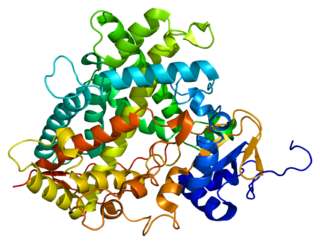Related Research Articles

Cytochromes P450 (CYPs) are a superfamily of enzymes containing heme as a cofactor that functions as monooxygenases. In mammals, these proteins oxidize steroids, fatty acids, and xenobiotics, and are important for the clearance of various compounds, as well as for hormone synthesis and breakdown. In 1963, Estabrook, Cooper, and Rosenthal described the role of CYP as a catalyst in steroid hormone synthesis and drug metabolism. In plants, these proteins are important for the biosynthesis of defensive compounds, fatty acids, and hormones.

Cytochrome P450 3A4 is an important enzyme in the body, mainly found in the liver and in the intestine. It oxidizes small foreign organic molecules (xenobiotics), such as toxins or drugs, so that they can be removed from the body. It is highly homologous to CYP3A5, another important CYP3A enzyme.

Cytochrome P450 2E1 is a member of the cytochrome P450 mixed-function oxidase system, which is involved in the metabolism of xenobiotics in the body. This class of enzymes is divided up into a number of subcategories, including CYP1, CYP2, and CYP3, which as a group are largely responsible for the breakdown of foreign compounds in mammals.
Dauer describes an alternative developmental stage of nematode worms, particularly rhabditids including Caenorhabditis elegans, whereby the larva goes into a type of stasis and can survive harsh conditions. Since the entrance of the dauer stage is dependent on environmental cues, it represents a classic and well studied example of polyphenism. The dauer state is given other names in the various types of nematodes such as ‘diapause’ or ‘hypobiosis’, but since the C. elegans nematode has become the most studied nematode, the term ‘dauer stage’ or 'dauer larvae' is becoming universally recognised when referring to this state in other free-living nematodes. The dauer stage is also considered to be equivalent to the infective stage of parasitic nematode larvae.

Cytochrome P450 1A2, a member of the cytochrome P450 mixed-function oxidase system, is involved in the metabolism of xenobiotics in the human body. In humans, the CYP1A2 enzyme is encoded by the CYP1A2 gene.

Cytochrome P450 family 2 subfamily C member 9 is an enzyme protein. The enzyme is involved in metabolism, by oxidation, of both xenobiotics, including drugs, and endogenous compounds, including fatty acids. In humans, the protein is encoded by the CYP2C9 gene. The gene is highly polymorphic, which affects the efficiency of the metabolism by the enzyme.

Cytochrome P450, family 1, subfamily A, polypeptide 1 is a protein that in humans is encoded by the CYP1A1 gene. The protein is a member of the cytochrome P450 superfamily of enzymes.

Cynthia Jane Kenyon is an American molecular biologist and biogerontologist known for her genetic dissection of aging in a widely used model organism, the roundworm Caenorhabditis elegans. She is the vice president of aging research at Calico Research Labs, and emeritus professor of biochemistry and biophysics at the University of California, San Francisco (UCSF).

Cytochrome P450 2C18 is a protein that in humans is encoded by the CYP2C18 gene.

Cytochrome P450 4A11 is a protein that in humans is codified by the CYP4A11 gene.

Cytochrome P450 2S1 is a protein that in humans is encoded by the CYP2S1 gene. The gene is located in chromosome 19q13.2 within a cluster including other CYP2 family members such as CYP2A6, CYP2A13, CYP2B6, and CYP2F1.

Leukotriene-B(4) omega-hydroxylase 2 is an enzyme that in humans is encoded by the CYP4F3 gene. CYP4F3 encodes two distinct enzymes, CYP4F3A and CYP4F3B, which originate from the alternative splicing of a single pre-mRNA precursor molecule; selection of either isoform is tissue-specific with CYP3F3A being expressed mostly in leukocytes and CYP4F3B mostly in the liver.

Cytochrome P450 26B1 is a protein that in humans is encoded by the CYP26B1 gene.

CYP4F22 is a protein that in humans is encoded by the CYP4F22 gene.
The DAF-12 gene encodes the nuclear receptor of dafachronic acid in the worm Caenorhabditis elegans, with the NRNC Symbol NR1J1 as the homolog of nuclear hormone receptor HR96 in Drosophila melanogaster. DAF-12 has been implicated by Cynthia Kenyon and colleagues in the formation of Dauer larva.
The Dod-13 gene in the worm Caenorhabditis elegans encoding a cytochrome p450 enzyme, which have steroid hydroxylase activity, with the CYP Symbol CYP35B1. Dod-13 is downstream gene of Daf-16 influenced the lifespan of C. elegans.
Cytochrome P450, family 13, also known as CYP13, is a nematoda cytochrome P450 monooxygenase family. The first gene identified in this family is the CYP13A1 from the Caenorhabditis elegans.
Cytochrome P450, family 14, also known as CYP14, is a nematoda cytochrome P450 monooxygenase family. The first gene identified in this family is the CYP14A1 from the Caenorhabditis elegans. The function of most genes in this family is unknown.
Cytochrome P450, family 23, also known as CYP23, is a nematoda cytochrome P450 monooxygenase family. The first gene identified in this family is the CYP23A1 from the Caenorhabditis elegans, is a homolog of the human gene CYP7B1.

The age-1 gene is located on chromosome 2 in C.elegans. It gained attention in 1983 for its ability to induce long-lived C. elegans mutants. The age-1 mutant, first identified by Michael Klass, was reported to extend mean lifespan by over 50% at 25 °C when compared to the wild type worm (N2) in 1987 by Johnson et al. Development, metabolism, lifespan, among other processes have been associated with age-1 expression. The age-1 gene is known to share a genetic pathway with daf-2 gene that regulates lifespan in worms. Additionally, both age-1 and daf-2 mutants are dependent on daf-16 and daf-18 genes to promote lifespan extension.
References
- ↑ Jia K, Albert PS, Riddle DL (2002). "DAF-9, a cytochrome P450 regulating C. elegans larval development and adult longevity". Development . 129 (1): 221–31. doi:10.1242/dev.129.1.221. PMID 11782415.
- ↑ Kenyon C, Chang J, Gensch E, Rudner A, Tabtiang R (1993). "A C. elegans mutant that lives twice as long as wild type". Nature . 366 (6454): 461–464. Bibcode:1993Natur.366..461K. doi:10.1038/366461a0. PMID 8247153. S2CID 4332206.